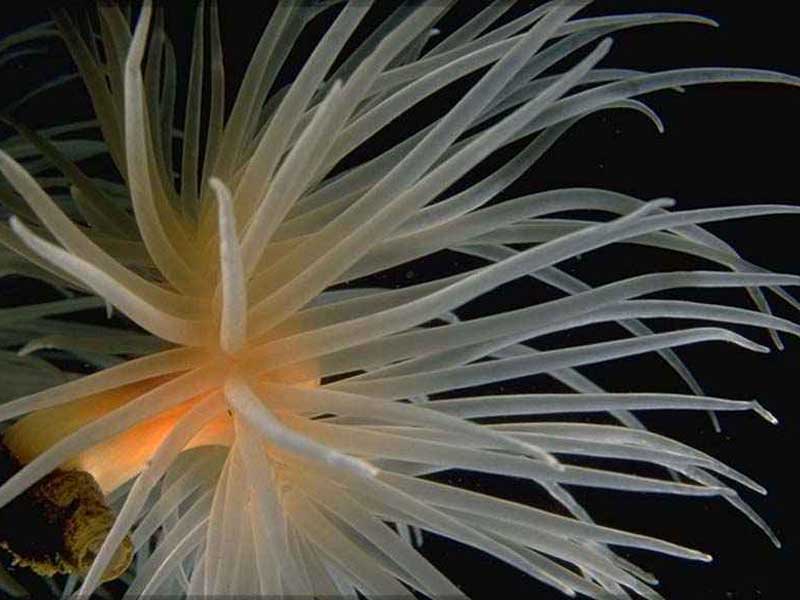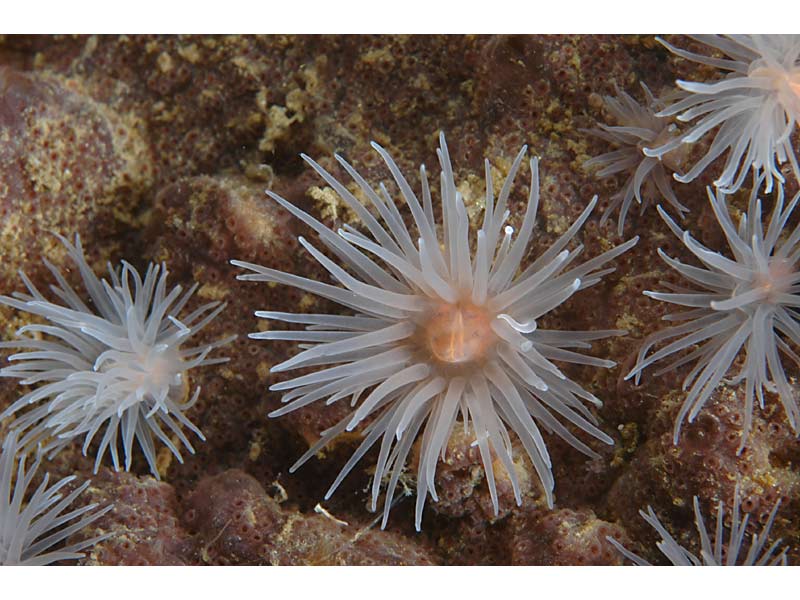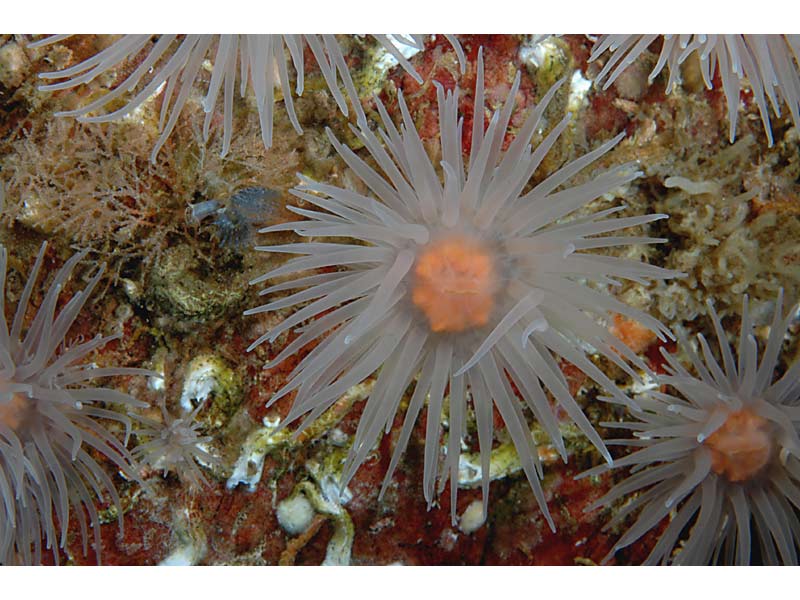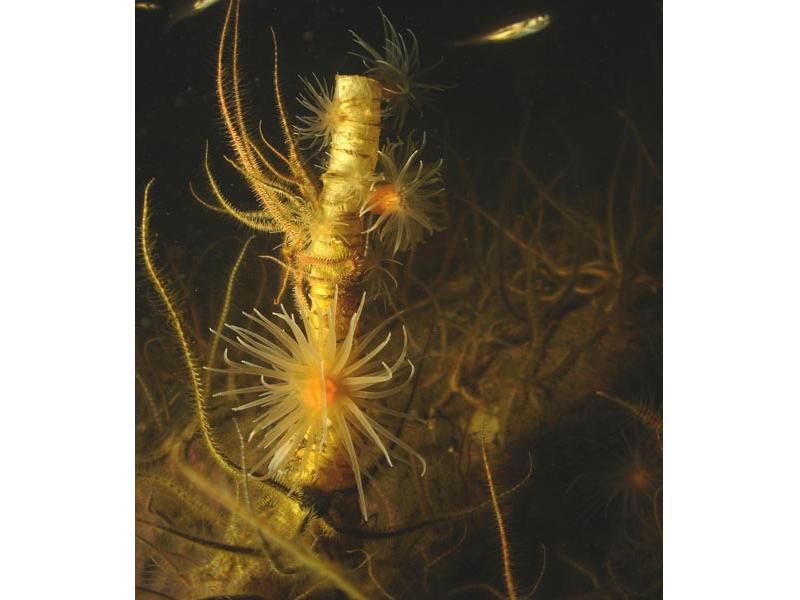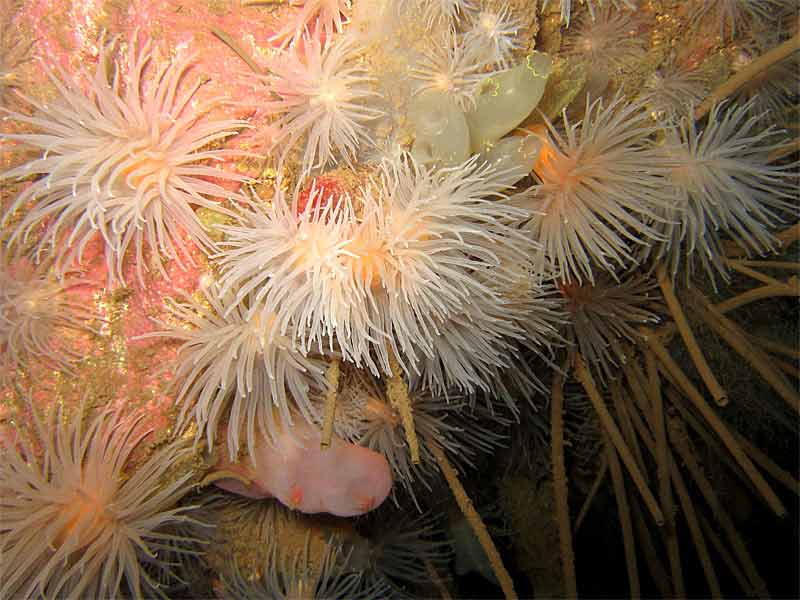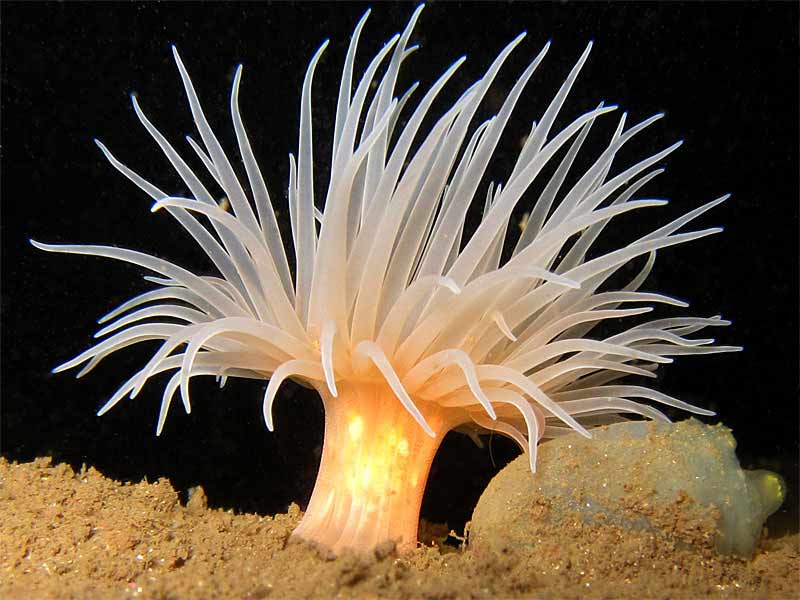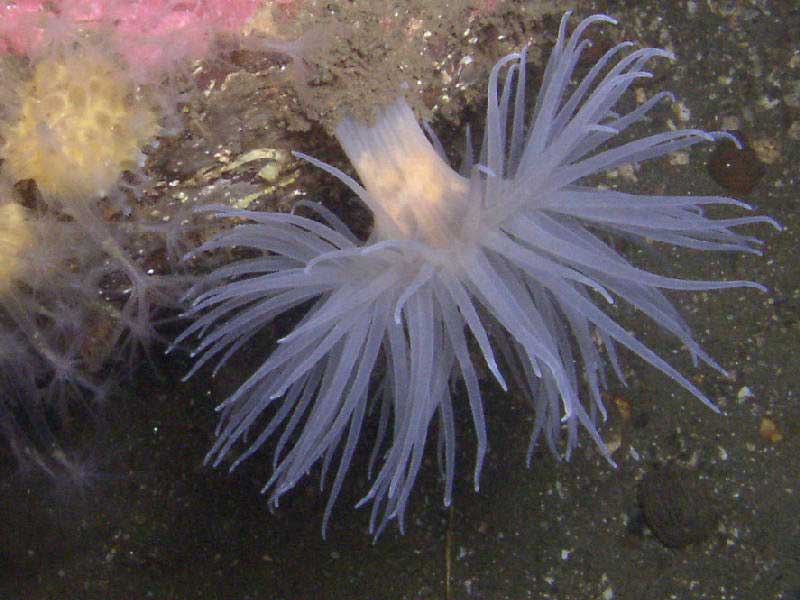Sealoch anemone (Protanthea simplex)
Distribution data supplied by the Ocean Biodiversity Information System (OBIS). To interrogate UK data visit the NBN Atlas.Map Help
| Researched by | Angus Jackson | Refereed by | Dr Ib Svane |
| Authority | Carlgren, 1891 | ||
| Other common names | - | Synonyms | - |
Summary
Description
Recorded distribution in Britain and Ireland
From the northern Firth of Clyde all along the west coast of Scotland, particularly in sea lochs. Not recorded in Orkney or Shetland. Recently (June 2006) found in Killary Harbour, Connemara.Global distribution
Killary Harbour (Connermara, Galway), Western Scotland out to Rockall Bank, round the coasts of the Skagerrak and northern Kattegat, Norway.Habitat
Occurs characteristically on deep rock in sea lochs, particularly on vertical walls in landward basins. Often found growing on rock or on other species such as tube worms. Otherwise recorded in deep waters down to at least 500 m.Depth range
9 -500 m deepIdentifying features
- A small delicate sea anemone up to 2 cm high.
- Column is smooth and broader distally (1.5 cm) than proximally (1 cm).
- 100-160 tentacles arranged in 5 or 6 cycles.
- Inner tentacles up to 1.5 cm, outer tentacles shorter.
- There is no sphincter.
- Eight perfect mesenteries present.
Additional information
No text enteredListed by
- none -
Biology review
Taxonomy
| Level | Scientific name | Common name |
|---|---|---|
| Phylum | Cnidaria | Sea anemones, corals, sea firs & jellyfish |
| Class | Anthozoa | Sea anemones, soft & cup corals, sea pens & sea pansies |
| Order | Actiniaria | |
| Family | Gonactiniidae | |
| Genus | Protanthea | |
| Authority | Carlgren, 1891 | |
| Recent Synonyms | ||
Biology
| Parameter | Data | ||
|---|---|---|---|
| Typical abundance | Moderate density | ||
| Male size range | Up to 2cm | ||
| Male size at maturity | |||
| Female size range | Small(1-2cm) | ||
| Female size at maturity | |||
| Growth form | Cylindrical | ||
| Growth rate | Data deficient | ||
| Body flexibility | |||
| Mobility | |||
| Characteristic feeding method | Non-feeding, Passive suspension feeder | ||
| Diet/food source | |||
| Typically feeds on | Data deficient | ||
| Sociability | |||
| Environmental position | Epifaunal | ||
| Dependency | No information found. | ||
| Supports | No information | ||
| Is the species harmful? | Data deficient | ||
Biology information
This species exhibits an unusual collapse behaviour, where at intervals, muscle tone is rapidly lost and the animals hangs limply from its disk attachment. This is considered to be an egestion process rather than a feeding, alarm or escape response. Despite the primitive musculature, Protanthea simplex is capable of active movement.In Sweden Protanthea simplex has been recorded historically at densities of up to 2000 per square metre. Svane & Gröndal (1988) reported that the species was abundant below the algal belt in semi-sheltered and sheltered sites in the Gullmarsfjorden, Sweden (10.7 % and 4.5 % cover per 0.25 square metre respectively). This contrasted with earlier work by Gislén, undertaken between 1926-29, where the species was not recorded in the semi-sheltered sites and only made up a small proportion of the total wet weight of species in the sheltered sites (Svane & Gröndal, 1988).
Habitat preferences
| Parameter | Data |
|---|---|
| Physiographic preferences | Offshore seabed, Strait or Sound, Sea loch or Sea lough |
| Biological zone preferences | Lower circalittoral, Lower infralittoral, Upper circalittoral |
| Substratum / habitat preferences | Bedrock, Biogenic reef, Large to very large boulders, Small boulders |
| Tidal strength preferences | Very weak (negligible), Weak < 1 knot (<0.5 m/sec.) |
| Wave exposure preferences | Extremely sheltered, Sheltered, Ultra sheltered, Very sheltered |
| Salinity preferences | Full (30-40 psu), Variable (18-40 psu) |
| Depth range | 9 -500 m deep |
| Other preferences | No text entered |
| Migration Pattern | Non-migratory or resident |
Habitat Information
No text enteredLife history
Adult characteristics
| Parameter | Data |
|---|---|
| Reproductive type | Gonochoristic (dioecious) |
| Reproductive frequency | Annual episodic |
| Fecundity (number of eggs) | No information |
| Generation time | Insufficient information |
| Age at maturity | Insufficient information |
| Season | September - October |
| Life span | Insufficient information |
Larval characteristics
| Parameter | Data |
|---|---|
| Larval/propagule type | - |
| Larval/juvenile development | Oviparous |
| Duration of larval stage | 11-30 days |
| Larval dispersal potential | Greater than 10 km |
| Larval settlement period | Insufficient information |
Life history information
At 10-12 °C the larvae spend 15-20 days in the plankton before settling. In Sweden breeding occurs in September and October. Breeding terminates earlier in shallower water. Fertilization of the eggs occurs in the water column. The reproductive organs are white or orange- pink. Fragments of tissue in this species (except the tentacles) are capable of regenerating into complete anemones, a form of vegetative, asexual reproduction (Manuel, 1988).Apart from Protanthea simplex, the only other species in the family Gonactinidae is Gonactinia prolifera. Gonactinia prolifera is unique in that the planula larva carries 'collar cells' similar in structure to the choanocyes of sponges and it is possible that Protanthea simplex has similar cells (I. Svane, pers. comm.). These secretory cells contain yolk granules and are undoubtedly involved in the formation of the fibrous coating of the planula which is again a unique feature of its planula (Chia et al, 1989).
Sensitivity review
The MarLIN sensitivity assessment approach used below has been superseded by the MarESA (Marine Evidence-based Sensitivity Assessment) approach (see menu). The MarLIN approach was used for assessments from 1999-2010. The MarESA approach reflects the recent conservation imperatives and terminology and is used for sensitivity assessments from 2014 onwards.
Physical pressures
Use / to open/close text displayed
| Intolerance | Recoverability | Sensitivity | Evidence / Confidence | |
Substratum loss [Show more]Substratum lossBenchmark. All of the substratum occupied by the species or biotope under consideration is removed. A single event is assumed for sensitivity assessment. Once the activity or event has stopped (or between regular events) suitable substratum remains or is deposited. Species or community recovery assumes that the substratum within the habitat preferences of the original species or community is present. Further details EvidenceThe species is attached to the substratum so substratum loss will mean loss of the population. Although capable of active movement, this is not over long distances making adult immigration highly unlikely. No information is available about growth rate, longevity or fecundity. Larvae remain in the plankton for up to three weeks and so potentially have considerable dispersal potential. | High | Moderate | Moderate | High |
Smothering [Show more]SmotheringBenchmark. All of the population of a species or an area of a biotope is smothered by sediment to a depth of 5 cm above the substratum for one month. Impermeable materials, such as concrete, oil, or tar, are likely to have a greater effect. Further details. EvidenceThe species is delicate and soft bodied. Smothering with 5 cm of sediment is likely to cause physical damage to the anemone as well as restricting respiration and preventing feeding. Although capable of active movement, this is not over long distances making adult immigration highly unlikely. No information is available about growth rate, longevity or fecundity. Larvae remain in the plankton for up to three weeks and so potentially have considerable dispersal potential. | High | Moderate | Moderate | Low |
Increase in suspended sediment [Show more]Increase in suspended sedimentBenchmark. An arbitrary short-term, acute change in background suspended sediment concentration e.g., a change of 100 mg/l for one month. The resultant light attenuation effects are addressed under turbidity, and the effects of rapid settling out of suspended sediment are addressed under smothering. Further details EvidenceIncreased siltation may clog the anemone's tentacles and interfere with feeding. Clearing the sediment will require increased energetic expenditure. Loss of condition may result. It may take a few weeks or months for condition to be regained once energy expenditure returns to normal. | Low | Very high | Very Low | Low |
Decrease in suspended sediment [Show more]Decrease in suspended sedimentBenchmark. An arbitrary short-term, acute change in background suspended sediment concentration e.g., a change of 100 mg/l for one month. The resultant light attenuation effects are addressed under turbidity, and the effects of rapid settling out of suspended sediment are addressed under smothering. Further details Evidence | No information | |||
Desiccation [Show more]Desiccation
EvidenceThe anemone is small and soft bodied, existing entirely sub-tidally. On removal from the water the animals turn into shapeless blobs of tissue. Exposure to desiccating influences is highly likely to cause death. Although capable of active movement, this is not over long distances making adult immigration highly unlikely. No information is available about growth rate, longevity or fecundity. Larvae remain in the plankton for up to three weeks and so potentially have considerable dispersal potential. | High | Moderate | Moderate | Low |
Increase in emergence regime [Show more]Increase in emergence regimeBenchmark. A one hour change in the time covered or not covered by the sea for a period of one year. Further details EvidenceThe anemone is small and soft bodied, existing entirely sub-tidally. On removal from the water the animals turn into shapeless blobs of jelly. Emergence is highly likely to cause death. Although capable of active movement, this is not over long distances making adult immigration highly unlikely. No information is available about growth rate, longevity or fecundity. Larvae remain in the plankton for up to three weeks and so potentially have considerable dispersal potential. | High | Moderate | Moderate | Low |
Decrease in emergence regime [Show more]Decrease in emergence regimeBenchmark. A one hour change in the time covered or not covered by the sea for a period of one year. Further details Evidence | No information | |||
Increase in water flow rate [Show more]Increase in water flow rateA change of two categories in water flow rate (view glossary) for 1 year, for example, from moderately strong (1-3 knots) to very weak (negligible). Further details EvidenceDecreases in water flow are unlikely to have any effect but increases in flow rate above weak may prevent the animals from maintaining posture and interfere with feeding. Increased flow rates may also sweep individuals off the substratum. Although capable of active movement, this is not over long distances making adult immigration highly unlikely. No information is available about growth rate, longevity or fecundity. Larvae remain in the plankton for up to three weeks and so potentially have considerable dispersal potential. No information is available about asexual reproduction. | Intermediate | High | Low | Low |
Decrease in water flow rate [Show more]Decrease in water flow rateA change of two categories in water flow rate (view glossary) for 1 year, for example, from moderately strong (1-3 knots) to very weak (negligible). Further details Evidence | No information | |||
Increase in temperature [Show more]Increase in temperature
For intertidal species or communities, the range of temperatures includes the air temperature regime for that species or community. Further details EvidenceNo information is available about the temperature preferences of Protanthea simplex. However, the species reaches its southern-most geographical distribution in coastal waters on the west coast of Scotland. Long-term chronic increases in temperature may cause the distribution range of shallow water populations to retreat northwards. Although capable of active movement, this is not over long distances making adult immigration highly unlikely. No information is available about growth rate, longevity or fecundity. Larvae remain in the plankton for up to three weeks and so potentially have considerable dispersal potential. | High | Moderate | Moderate | Very low |
Decrease in temperature [Show more]Decrease in temperature
For intertidal species or communities, the range of temperatures includes the air temperature regime for that species or community. Further details Evidence | No information | |||
Increase in turbidity [Show more]Increase in turbidity
EvidenceThe species probably has very poor facility for visual perception and has no great requirement for light. The species may be found as deep as 400 m where light availability is very limited. Changes in light attenuation are not likely to have any effect. | Tolerant | Not relevant | Not sensitive | Low |
Decrease in turbidity [Show more]Decrease in turbidity
Evidence | No information | |||
Increase in wave exposure [Show more]Increase in wave exposureA change of two ranks on the wave exposure scale (view glossary) e.g., from Exposed to Extremely exposed for a period of one year. Further details EvidenceThe species typically inhabits sheltered waters so decreases in wave exposure are unlikely to have any effect. Increases above moderately exposed are likely to cause damage to the species, as well as interfering with posture and feeding. Deep water populations are unlikely to be affected by changes in wave exposure. | High | Moderate | Moderate | Low |
Decrease in wave exposure [Show more]Decrease in wave exposureA change of two ranks on the wave exposure scale (view glossary) e.g., from Exposed to Extremely exposed for a period of one year. Further details Evidence | No information | |||
Noise [Show more]Noise
EvidenceProtanthea simplex probably has limited facility for detection of noise vibrations. It is unlikely to be sensitive to noise. | Tolerant | Not relevant | Not sensitive | Very low |
Visual presence [Show more]Visual presenceBenchmark. The continuous presence for one month of moving objects not naturally found in the marine environment (e.g., boats, machinery, and humans) within the visual envelope of the species or community under consideration. Further details EvidenceProtanthea simplex probably has limited facility for visual perception. It is unlikely to be sensitive to visual disturbance. | Tolerant | Not relevant | Not sensitive | High |
Abrasion & physical disturbance [Show more]Abrasion & physical disturbanceBenchmark. Force equivalent to a standard scallop dredge landing on or being dragged across the organism. A single event is assumed for assessment. This factor includes mechanical interference, crushing, physical blows against, or rubbing and erosion of the organism or habitat of interest. Where trampling is relevant, the evidence and trampling intensity will be reported in the rationale. Further details. EvidenceThe anemone is delicate and soft bodied. Abrasion is highly likely to cause death. Although capable of active movement, this is not over long distances making adult immigration highly unlikely. No information is available about growth rate, longevity or fecundity. Larvae remain in the plankton for up to three weeks and so potentially have considerable dispersal potential. | High | Moderate | Moderate | Low |
Displacement [Show more]DisplacementBenchmark. Removal of the organism from the substratum and displacement from its original position onto a suitable substratum. A single event is assumed for assessment. Further details EvidenceProtanthea simplex only forms a temporary attachment with the substratum and is capable of active movement. Displacement may cause inconvenience for the animals and possibly slight damage to the body but is not likely to cause death. It may take a few weeks or months for regeneration and repair of damage to occur. | Low | Very high | Very Low | Low |
Chemical pressures
Use [show more] / [show less] to open/close text displayed
| Intolerance | Recoverability | Sensitivity | Evidence / Confidence | |
Synthetic compound contamination [Show more]Synthetic compound contaminationSensitivity is assessed against the available evidence for the effects of contaminants on the species (or closely related species at low confidence) or community of interest. For example:
The evidence used is stated in the rationale. Where the assessment can be based on a known activity then this is stated. The tolerance to contaminants of species of interest will be included in the rationale when available; together with relevant supporting material. Further details. EvidenceInsufficientinformation | No information | No information | No information | Not relevant |
Heavy metal contamination [Show more]Heavy metal contaminationEvidenceInsufficientinformation | No information | No information | No information | Not relevant |
Hydrocarbon contamination [Show more]Hydrocarbon contaminationEvidenceInsufficientinformation | No information | No information | No information | Not relevant |
Radionuclide contamination [Show more]Radionuclide contaminationEvidenceInsufficientinformation | No information | No information | No information | Not relevant |
Changes in nutrient levels [Show more]Changes in nutrient levelsEvidenceInsufficientinformation | No information | No information | No information | Not relevant |
Increase in salinity [Show more]Increase in salinity
EvidenceThe species probably only inhabits fully saline waters but this is not certain. Longer term decreases in salinity may cause some of the population to die. Although capable of active movement, this is not over long distances making adult immigration highly unlikely. No information is available about growth rate, longevity or fecundity. Larvae remain in the plankton for up to three weeks and so potentially have considerable dispersal potential. No information is available about asexual reproduction. | Intermediate | High | Low | Low |
Decrease in salinity [Show more]Decrease in salinity
Evidence | No information | |||
Changes in oxygenation [Show more]Changes in oxygenationBenchmark. Exposure to a dissolved oxygen concentration of 2 mg/l for one week. Further details. EvidenceCole et al. (1999) suggest possible adverse effects on marine species below 4 mg/l and probable adverse effects below 2mg/l. There is no information about Protanthea simplex tolerance to changes in oxygenation. Although capable of active movement, this is not over long distances making adult immigration highly unlikely. No information is available about growth rate, longevity or fecundity. Larvae remain in the plankton for up to three weeks and so potentially have considerable dispersal potential. | Intermediate | High | Low | Very low |
Biological pressures
Use [show more] / [show less] to open/close text displayed
| Intolerance | Recoverability | Sensitivity | Evidence / Confidence | |
Introduction of microbial pathogens/parasites [Show more]Introduction of microbial pathogens/parasitesBenchmark. Sensitivity can only be assessed relative to a known, named disease, likely to cause partial loss of a species population or community. Further details. EvidenceInsufficientinformation | No information | No information | No information | Not relevant |
Introduction of non-native species [Show more]Introduction of non-native speciesSensitivity assessed against the likely effect of the introduction of alien or non-native species in Britain or Ireland. Further details. EvidenceInsufficientinformation | No information | No information | No information | Not relevant |
Extraction of this species [Show more]Extraction of this speciesBenchmark. Extraction removes 50% of the species or community from the area under consideration. Sensitivity will be assessed as 'intermediate'. The habitat remains intact or recovers rapidly. Any effects of the extraction process on the habitat itself are addressed under other factors, e.g. displacement, abrasion and physical disturbance, and substratum loss. Further details. EvidenceIt is extremely unlikely that this species would be subject to extraction. | Not relevant | Not relevant | Not relevant | Low |
Extraction of other species [Show more]Extraction of other speciesBenchmark. A species that is a required host or prey for the species under consideration (and assuming that no alternative host exists) or a keystone species in a biotope is removed. Any effects of the extraction process on the habitat itself are addressed under other factors, e.g. displacement, abrasion and physical disturbance, and substratum loss. Further details. EvidenceSome individual Protanthea simplex use other species such as Ascidia sp., Serpula sp., and Chaetopterus sp. as substrata. Removal of these species may also mean incidental removal of the anemone. It is unlikely that available habitat will be greatly reduced as Protanthea simplex also inhabits rock. Although capable of active movement, this is not over long distances making adult immigration highly unlikely. No information is available about growth rate, longevity or fecundity. Larvae remain in the plankton for up to three weeks and so potentially have considerable dispersal potential. | Intermediate | High | Low | Moderate |
Additional information
Importance review
Policy/legislation
- no data -
Status
| National (GB) importance | - | Global red list (IUCN) category | - |
Non-native
| Parameter | Data |
|---|---|
| Native | - |
| Origin | - |
| Date Arrived | Not relevant |
Importance information
-none-Bibliography
Carlgren, O., 1893. Studien uber nordische Actinien. Kungliga Svenska Vetenskaps-Akademiens Handlingar, 25, 148pp.
Carlgren, O., 1921. Actiniaria. Pt. 1. Danish Ingolf Expedition, Vol. V, No. 9., pp. 31. Copenhagen: Bianco Luno.
Carlgren, O., 1949. A survey of the Ptychodactiaria, Corallimorpharia and Actiniaria. Kungliga Svenska Vetenskapsakadamiens Handlingar, Series 4, 1, 16-110.
Chia, F-S., Lützen, J. & Svane, I., 1989. Sexual reproduction and larval morphology of the primitive anthozoan Gonactinia prolifera M. Sars. Journal of Experimental Marine Biology and Ecology, 127, 13-24.
Howson, C.M. & Picton, B.E., 1997. The species directory of the marine fauna and flora of the British Isles and surrounding seas. Belfast: Ulster Museum. [Ulster Museum publication, no. 276.]
Manuel, R.L., 1988. British Anthozoa. Synopses of the British Fauna (New Series) (ed. D.M. Kermack & R.S.K. Barnes). The Linnean Society of London [Synopses of the British Fauna No. 18.]. DOI https://doi.org/10.1002/iroh.19810660505
McFarlane, I.D., 1985. Collapse behaviour in the primitive sea anemone Protanthea simplex. Marine Behaviour and Physiology, 11, 259-269.
Nyholm, K-G., 1959. On the development of the primitive actinian Protanthea simplex, Carlgren. Zoologiska Bidrag Fran Uppsala, Band 33 1958-1962, 69-78.
Svane, I. & Dolmer, P., 1995. Perception of light at settlement: a comparative study of two invertebrate larvae, a scyphozoan planula and a simple ascidian tadpole. Journal of Experimental Marine Biology and Ecology, 187, 51-61.
Svane, I. & Groendahl, F., 1988. Epibioses of Gullmarsfjorden: an underwater stereophotographical transect analysis in comparison with the investigations of Gislen in 1926-29. Ophelia, 28, 95-110.
Datasets
NBN (National Biodiversity Network) Atlas. Available from: https://www.nbnatlas.org.
OBIS (Ocean Biodiversity Information System), 2025. Global map of species distribution using gridded data. Available from: Ocean Biogeographic Information System. www.iobis.org. Accessed: 2025-08-13
Citation
This review can be cited as:
Last Updated: 24/04/2008

